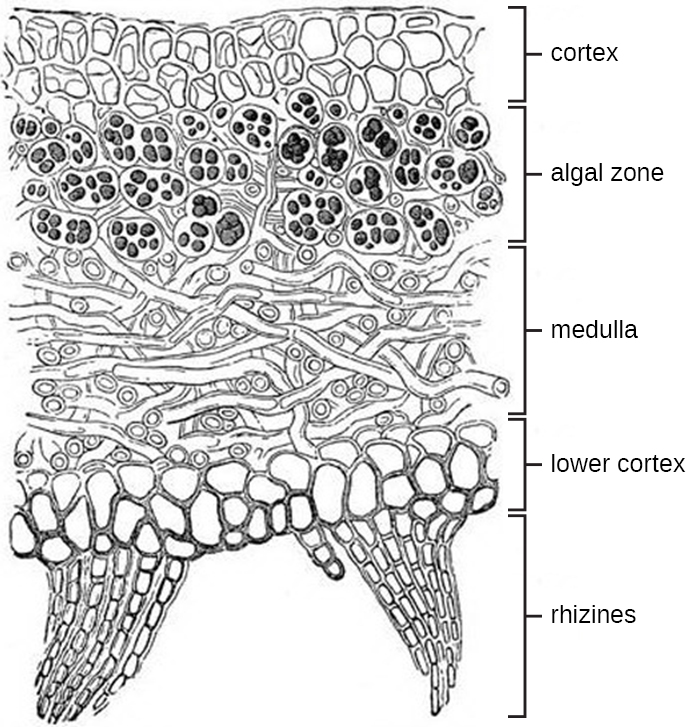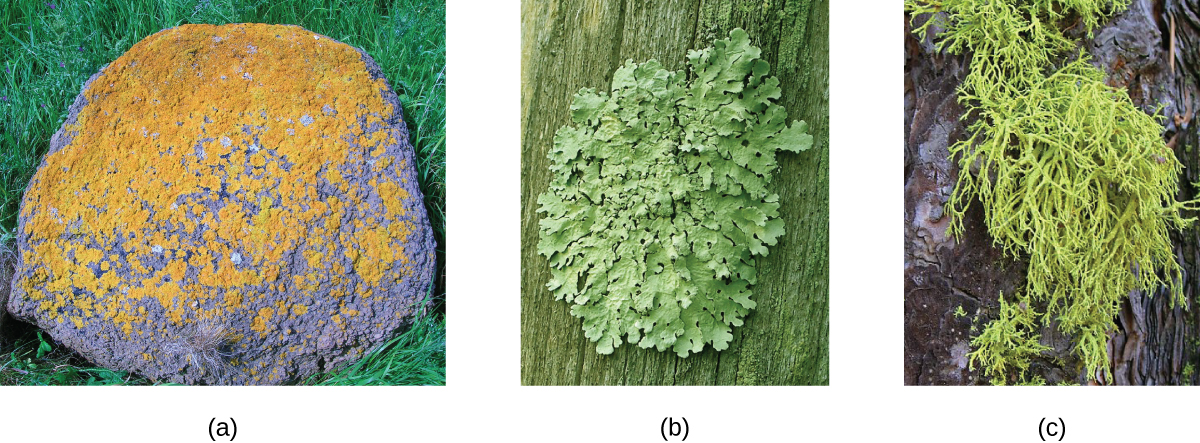5.5 – Lichens
Learning Objectives
- Explain why lichens are included in the study of microbiology
- Describe the unique characteristics of a lichen and the role of each partner in the symbiotic relationship of a lichen
- Describe ways in which lichens are beneficial to the environment
No one has to worry about getting sick from a lichen infection, but lichens are interesting from a microbiological perspective and they are an important component of most terrestrial ecosystems. Lichens provide opportunities for study of close relationships between unrelated microorganisms. Lichens contribute to soil production by breaking down rock, and they are early colonizers in soilless environments such as lava flows. The cyanobacteria in some lichens can fix nitrogen and act as a nitrogen source in some environments. Lichens are also important soil stabilizers in some desert environments and they are an important winter food source for caribou and reindeer. Finally, lichens produce compounds that have antibacterial effects, and further research may discover compounds that are medically useful to humans.
Characteristics
A lichen is a combination of two organisms, a green alga or cyanobacterium and fungus, living in a symbiotic relationship. Whereas algae normally grow only in aquatic or extremely moist environments, lichens can potentially be found on almost any surface (especially rocks) or as epiphytes (meaning that they grow on other plants).
In some ways, the symbiotic relationship between lichens and algae seems like a mutualism (a relationship in which both organisms benefit). The fungus can obtain photosynthates from the algae or cyanobacterium and the algae or cyanobacterium can grow in a drier environment than it could otherwise tolerate. However, most scientists consider this symbiotic relationship to be a controlled parasitism (a relationship in which one organism benefits and the other is harmed) because the photosynthetic organism grows less well than it would without the fungus. It is important to note that such symbiotic interactions fall along a continuum between conflict and cooperation.
Lichens are slow growing and can live for centuries. They have been used in foods and to extract chemicals as dyes or antimicrobial substances. Some are very sensitive to pollution and have been used as environmental indicators.
Lichens have a body called a thallus, an outer, tightly packed fungal layer called a cortex, and an inner, loosely packed fungal layer called a medulla (Figure 5.38). Lichens use hyphal bundles called rhizines to attach to the substrate.

Lichen Diversity
Lichens are classified as fungi and the fungal partners belong to the Ascomycota and Basidiomycota. Lichens can also be grouped into types based on their morphology. There are three major types of lichens, although other types exist as well. Lichens that are tightly attached to the substrate, giving them a crusty appearance, are called crustose lichens. Those that have leaf-like lobes are foliose lichens; they may only be attached at one point in the growth form, and they also have a second cortex below the medulla. Finally, fruticose lichens have rounded structures and an overall branched appearance. Figure 5.39 shows an example of each of the forms of lichens.

Check Your Understanding
- What types of organisms are found in lichens?
- What are the three growth forms of lichens?

